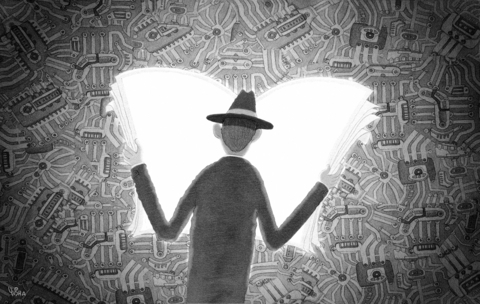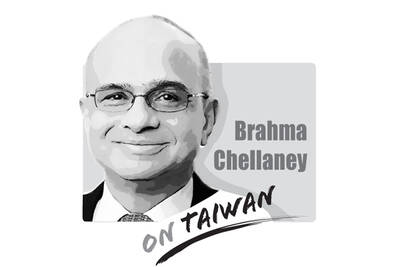It won't be long before buying a copy of the Economist at your local newsagent could become as niche an activity as buying a vinyl LP. Instead of leisurely flicking through a magazine on the sofa with a cup of tea, you will read it on the Web, download it on to a piece of e-paper or simply publish it yourself.
According to David Renard, author of The Last Magazine, in the next 25 years, only 10 percent of the European and US paper-based magazine industry will remain, kept alive by "connoisseurs, aficionados and ageing Luddites."
The rest of us will embrace the publishing revolution. Instead of nipping to the newsagent, you will download the day's news, sport or business pages from a vending machine and read it on a piece of e-paper. And when you finish, you'll put the e-paper in your briefcase and update the content the next day.

E-paper is already available: Sony introduced its e-book device last year, but Japanese company Fujitsu will launch what it claims is the first color e-paper next year. According to Mike Nelson, Fujitsu's European general manager, e-paper is "exceptionally useful."
"It looks like color newsprint, it is tough, flexible, very thin and you could change the image on it every two seconds for a year using a triple-A battery," he said.
But will it replace traditional printed products?
"Well you can't fold it," Nelson admitted. "But we're not looking at tabloid or broadsheet size we're looking at something smaller. I think it will offer an alternative to newspapers."
"People already read newspapers and magazines online but it's not very convenient when you're on the move, so you can download what you want on to e-paper, take it with you and update it when you want," he said.
Fujitsu also believes that e-paper offers advertisers greater flexibility.
"Instead of sending a man up a ladder with a bucket of paste to stick up a poster, you can change an advertising message electronically," Nelson said.
The company, like other electronics firms, is also investing heavily in steganography. This involves embedding data in a photograph which can then be decoded using a camera phone.
"You can embed a barcode, phone number or URL [uniform resource locator] into a poster or an ad. You can't see it, but if you point a camera phone or PDA [personal digital assistant] at the image then it decodes it so you can download the information," Nelson explained.
The technology is already being used in Japan where members of a music club get flyers containing reviews.
"If you're interested in the review then you use your phone to click on the embedded data and a music clip is then played on your mobile," he said.
Nelson claimed it will also help advertisers identify if a campaign is working. If people aren't clicking on your ad with their mobiles then you can simply change the campaign.
New technology will not only have an impact on distribution, but also on content, according to Ian Eckert, director of digital development at CMPi, part of United Business Media.
"Publishers have to accept that the world has changed," he said. "Web 2.0 isn't about pushing out information to your audience -- it's participatory and inclusive like MySpace or YouTube. The audience and the content is blurred and that's a real challenge. In the past, participation meant a letters page or a feedback slot, but that's essentially one-way traffic. Now, it's two-way traffic where people can gather around a brand 365 days a year."
VNU is another publisher attempting to get closer to its audience. It now runs live online, interactive video seminars so that audiences can take part in industry events without leaving their desks.
But for some audiences, it's not just about taking part, it's about taking over.
"Traditional publishing is already coexisting with the revolutionary phenomenon of social publishing, where people cluster together to create their own content," said Tamar Kasriel, head of knowledge venturing at forecasting company, the Henley Center.
"The media giants are taking it very seriously, which is why Google announced that it will share advertising revenue with the users of YouTube," she said.
The role of publishers will change, Eckert added.
"I don't think we will get rid of journalists, but there will be less pontification from on high and more conversation," he said. "Our role is to shift what's important. I don't think everyone can become a publisher because individuals would find it very hard to do."
Dominic Williams, managing director of digital publishing technology firm, System 7, goes further. Social publishing, he said, will be huge.
"It addresses all niches out there: professional, hobby, social and political," he said.
"I think it's very likely that social publishing will replace trade publishing altogether. For example, if you are a tax consultant, you can create content and a guide to tax. If people like it they can vote for it and it will get noticed out there," Williams said.
He agreed social publishing will pose threats but believes it is also an opportunity for traditional publishers.
"It allows audience and content publishers to meet each other to share and talk. It's a big opportunity if you're building a brand and can get an audience to seed that publication," he said.
He cites Imagine FX, an online fantasy art magazine which System 7 helped to develop. By opening an online gallery and inviting people to post their own work, the site and the magazine gained 3 million page impressions in three weeks.
"If publishers have a deeper relationship with the community they are serving, they will get more traffic and more advertising revenue," Williams said.
Publishers engaging with social publishing can also look forward to a different model when it comes to remunerating the creators of their content.
"Journalists will [increasingly] become freelance, but they will get a share of the advertising revenue if their stuff is read and will make a lot of money if they are at the top of the rankings," he said.
"Social publishing might mean that there's a lot of rubbish written, but author ranking technology can judge which is the highest quality content, so the best rises to the top," he said.

As strategic tensions escalate across the vast Indo-Pacific region, Taiwan has emerged as more than a potential flashpoint. It is the fulcrum upon which the credibility of the evolving American-led strategy of integrated deterrence now rests. How the US and regional powers like Japan respond to Taiwan’s defense, and how credible the deterrent against Chinese aggression proves to be, will profoundly shape the Indo-Pacific security architecture for years to come. A successful defense of Taiwan through strengthened deterrence in the Indo-Pacific would enhance the credibility of the US-led alliance system and underpin America’s global preeminence, while a failure of integrated deterrence would
The Executive Yuan recently revised a page of its Web site on ethnic groups in Taiwan, replacing the term “Han” (漢族) with “the rest of the population.” The page, which was updated on March 24, describes the composition of Taiwan’s registered households as indigenous (2.5 percent), foreign origin (1.2 percent) and the rest of the population (96.2 percent). The change was picked up by a social media user and amplified by local media, sparking heated discussion over the weekend. The pan-blue and pro-China camp called it a politically motivated desinicization attempt to obscure the Han Chinese ethnicity of most Taiwanese.
It is being said every second day: The ongoing recall campaign in Taiwan — where citizens are trying to collect enough signatures to trigger re-elections for a number of Chinese Nationalist Party (KMT) legislators — is orchestrated by the Democratic Progressive Party (DPP), or even President William Lai (賴清德) himself. The KMT makes the claim, and foreign media and analysts repeat it. However, they never show any proof — because there is not any. It is alarming how easily academics, journalists and experts toss around claims that amount to accusing a democratic government of conspiracy — without a shred of evidence. These
On Wednesday last week, the Rossiyskaya Gazeta published an article by Chinese President Xi Jinping (習近平) asserting the People’s Republic of China’s (PRC) territorial claim over Taiwan effective 1945, predicated upon instruments such as the 1943 Cairo Declaration and the 1945 Potsdam Proclamation. The article further contended that this de jure and de facto status was subsequently reaffirmed by UN General Assembly Resolution 2758 of 1971. The Ministry of Foreign Affairs promptly issued a statement categorically repudiating these assertions. In addition to the reasons put forward by the ministry, I believe that China’s assertions are open to questions in international